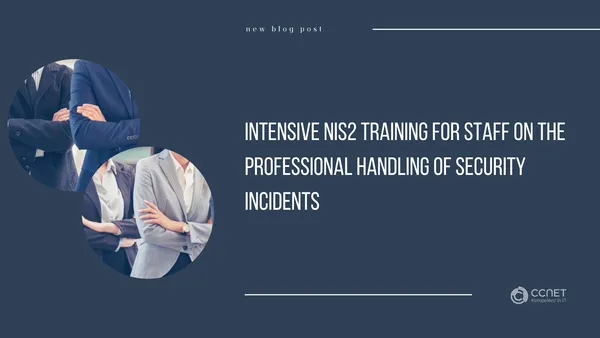
CCNet
Jan 27, 2025 • 2 min read

Intensive NIS2 training for staff on the professional handling of security incidents
The process of employee training aims to ensure that all relevant individuals in the company are optimally prepared to handle cybersecurity incidents. The goal is to strengthen the ability to correctly identify incidents, respond quickly, and minimize damage through regular training and simulations, thus ensuring the company's security.
Training Scope
This training process applies to all employees who are directly or indirectly involved with the company's IT and data security. The focus is particularly on the Incident Response Team, IT staff, department heads, and key personnel in security-sensitive areas.
Training Steps
Identifying Training Needs
In coordination with department heads, the IT security officer analyzes the specific training needs. This includes assessing which employees require which skills and knowledge to fulfill security-critical roles and responsibilities.
Creating a Training Plan
An annual training plan is developed, covering all essential topics in the area of cybersecurity. This includes incident detection and reporting, response actions, using security tools, and communication strategies during an incident. The plan also includes regular simulations that replicate real incidents.
Conducting Training
The IT security officer conducts training sessions that may include both theoretical content and practical exercises, depending on the need. External security experts may be involved to cover specialized topics or assist with training.
Simulating Security Incidents
To test practical response capabilities, simulations of real cybersecurity incidents are carried out. These exercises prepare employees for real-life situations and help evaluate existing processes. A subsequent review helps identify areas for improvement.
Evaluating Training Results
After each training and simulation, an evaluation is conducted to assess effectiveness. Feedback from participants is gathered, and the results are analyzed to optimize future training sessions and tailor them to the specific needs of the workforce.
Updating Training Content
Training content is regularly reviewed and updated. New threat scenarios, recent security incidents, and best practices are taken into account to keep the training relevant and up to date.
Documentation and Follow-Up
Each training and simulation session is carefully documented. Employee participation is recorded to ensure that all relevant individuals regularly attend training sessions. This documentation also serves as evidence for audits and compliance requirements.
Responsibilities
- IT Security Officer: Develops and implements the training plan, conducts training and simulations, and evaluates their effectiveness.
- Department Heads: Assist in identifying training needs and ensure their employees participate in training.
- Employees: Are required to attend training and apply the skills learned in their daily work.
Reporting
Regular reports are created to give management an overview of completed training and simulations. These reports include information on participation, effectiveness, and recommendations for improving future training efforts.
Continuous Improvement
The training process is continuously reviewed and improved. Feedback from trainees and simulation results are incorporated into the process to adapt to new threats and requirements, ensuring the effectiveness of the measures.
Conclusion
Intensive and continuous employee training is crucial for effectively protecting the company against cybersecurity incidents and fostering a proactive security culture. By using structured training plans, practical simulations, and regularly updating content, the company ensures that all employees are prepared and capable of responding in the event of an incident. The documentation and evaluation of training sessions ensure not only compliance with NIS2 but also provide a basis for continuous process improvement. With a focus on professional handling, the company stays prepared for new threats and challenges, strengthening the security of its IT infrastructure.